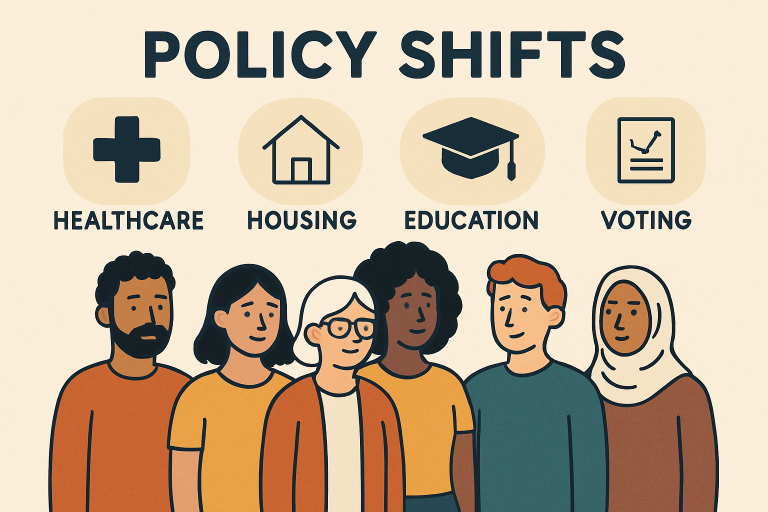Policy Shifts and Their Effect on Marginalized Communities in the U.S.

Policy changes at both the federal and state levels can have significant repercussions for marginalized communities across the United States. Adjustments to social programs, education funding, and voting rights can have a significant impact on access to essential resources, representation, and long-term opportunities. In 2024 and 2025, pivotal debates—such as those surrounding Project 2025 and Black families—have brought renewed focus to how policy frameworks can shape the lives of communities of color, LGBTQ+ Americans, Indigenous peoples, and other historically marginalized groups. Ensuring that policy shifts are evaluated through an equity lens is essential for advancing justice and improving outcomes for all citizens. The consequences of policy realignments can be profoundly unequal. For example, drastic funding changes to social safety nets or public health can push at-risk groups further into insecurity.
Table of Contents
Healthcare Access
Healthcare reform efforts represent one of the most consequential arenas for marginalized communities. Proposed Medicaid cuts in 2025, for instance, have threatened to curtail coverage for millions of Black, Latino, and Native American individuals—groups already facing disproportionate health burdens. In districts where Medicaid insures the majority of Latino or Black residents, even minor funding reductions can increase wait times, undermine access to specialists, or force families to forgo care altogether. These challenges underscore the real risk of worsening health disparities unless lawmakers maintain robust safety-net programs.
Housing Stability
The intersection of housing policy and racial equity is a longstanding concern. During the COVID-19 pandemic and its aftermath, Black and Latino renters were at heightened risk of eviction and homelessness due to job losses and a lack of generational wealth. Systemic issues—including redlining, discriminatory lending, and disinvestment in communities of color—have set the stage for these present-day disparities. Policy interventions that prioritize affordable housing construction, expanded rental assistance, and strengthened tenant protections are necessary for narrowing racial gaps in housing security.
Environmental Justice
Marginalized communities are disproportionately exposed to polluting industries, hazardous waste sites, and unhealthy air and water. Environmental racism—whereby communities of color are frequently situated near highways, power plants, or landfills—directly contributes to higher rates of asthma, cancer, and developmental issues for children. Many local and national environmental policies have failed to allocate resources equitably or address these legacy harms. Efforts at environmental justice, including stricter regulatory oversight and community-driven advocacy, are crucial for closing the environmental health gap.
Economic Opportunities
Access to economic opportunity—including jobs, fair wages, and wealth-building tools—remains shaped by both historical context and current policy. The threat of Medicaid cuts, as debated in 2025, is notable not only for its direct health implications but also for its economic consequences; Black and Hispanic households disproportionately rely on such benefits, and reductions can force tough choices between work, health, and home. Economic policy decisions ranging from minimum wage reforms to small-business loans can dramatically shift prospects for mobility and stability. Closing these gaps necessitates comprehensive, equity-focused reforms and better access to workforce development programs.

Education Equity
Educational outcomes persistently lag for students from marginalized communities due to funding disparities, punitive discipline policies, and exclusion from advanced coursework. According to the National Education Association, proposals like Project 2025 would exacerbate these inequities by reducing federal education funding, promoting private school vouchers, and limiting inclusive curricula. Such measures, alongside recent state laws limiting the teaching of critical race theory or LGBTQ+ content, risk erasing significant histories, undermining teacher autonomy, and alienating vulnerable students. Safeguarding access to a diverse and representative education remains essential for closing achievement gaps and expanding opportunity.
Criminal Justice Reform
Systemic bias in law enforcement, sentencing, and incarceration continues to affect marginalized groups at every stage of the criminal justice system. Black Americans are far more likely to face arrest or harsh sentencing, while Native and Latino populations also encounter bias and neglect in courts and policing. National efforts to address mass incarceration, racial profiling, and excessive sentencing have seen progress. Still, the pace and scope of reform remain inconsistent, often dictated by shifting political priorities and local leadership. Ongoing policy advocacy and oversight are necessary to ensure that community safety, equal protection, and restorative practices become the norm, not the exception.
Voting Rights
Robust voting rights are crucial for ensuring marginalized communities can influence policy decisions that affect their lives. However, legislative changes imposing stricter ID requirements, cutting polling locations, or reducing early voting disproportionately disenfranchise voters of color, young people, and people with disabilities. Recent years have seen an uptick in state-level policies that threaten broad-based democratic participation, undermining decades of hard-fought progress. Protecting and expanding voting access remains essential for building equitable policy outcomes and upholding democracy for all Americans.
Conclusion
Policy shifts—whether sweeping or incremental—shape the daily realities of marginalized communities across the United States. From healthcare and housing to environmental action, education, economic mobility, justice, and voting rights, each decision has a cumulative effect that can either close gaps or deepen inequities. The stakes are especially high for communities historically excluded from full participation in civic and economic life, as these shifts often determine access to resources, protections, and opportunities.
By recognizing and addressing these impacts with a sustained commitment to equity and inclusion, society can move closer to a future in which every community enjoys opportunity, security, and representation. This requires not only intentional policymaking but also active public engagement, accountability, and investment in systems that dismantle structural barriers. Only through such collective effort can the promise of a truly equitable and representative democracy be realized.




